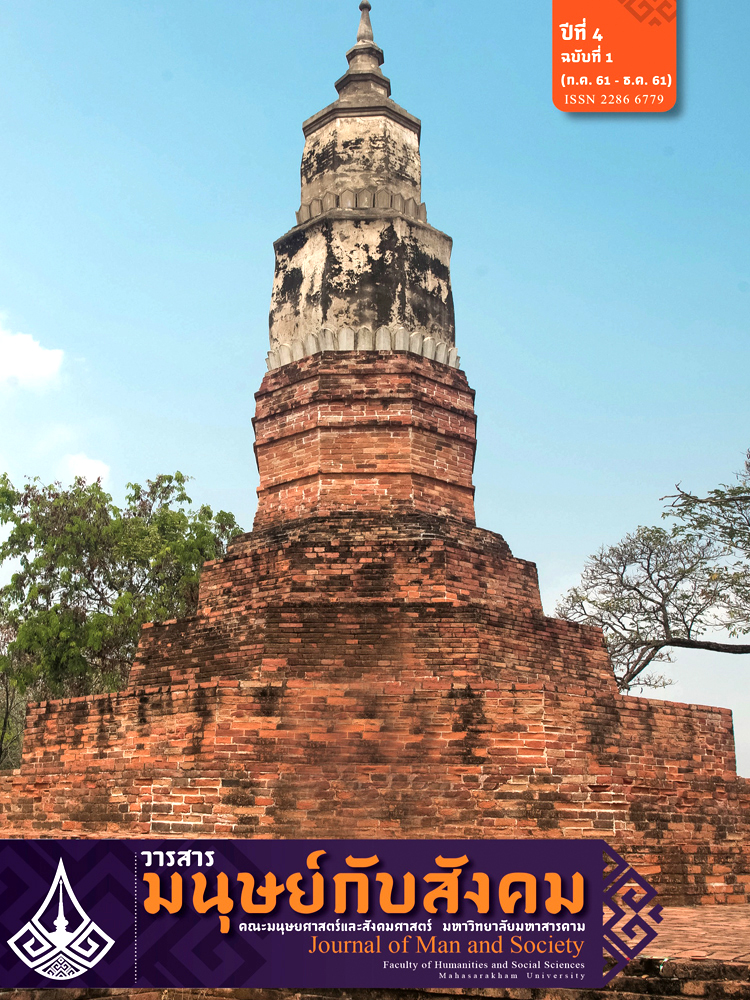SYNONYMOUS COMPOUNDS IN THE NORTHERN THAI DIALECT
Main Article Content
Abstract
Lexical meanings and origin of synonymous in the northern dialect thescope of which was in 8 provinces of the north. The data were drawn from dailyconversational speech of the people who use the northern dialect in MaehongsornChiengmai, Lampoon, Lampang, Chiengray, Phayao, Phrae and Nan There are 3types of synonymous compounds structure in the northern dialect; synonymouscompounds composed of 2 syllables, of 4 syllables and of more than 4 syllables.The lexical meanings of synonymous compounds were classified into 3 types; synonymous compounds having a meaning at either the initial or the final word whilethe other word had no meaning except, for rhyme, synonymous compounds havingmeanings at both words, and synonymous compounds having accurate meaning at either word while the other emphasized the meaning.
Article Details

This work is licensed under a Creative Commons Attribution-NonCommercial-NoDerivatives 4.0 International License.
เนื้อหาและข้อมูลที่ตีพิมพ์ลงในวารสารมนุษย์กับสังคม ถือเป็นข้อคิดเห็นและความรับผิดชอบโดยตรงของผู้เขียนซึ่งกองบรรณาธิการวารสารไม่จำเป็นต้องเห็นด้วยหรือร่วมรับผิดชอบใดๆ
บทความ ข้อมูล เนื้อหา รูปภาพ ฯลฯ ที่ได้รับการตีพิมพ์ในวารสารมนุษย์กับสังคม ถือเป็นลิขสิทธิ์ของวารสาร หากบุคคลหรือหน่วยงานใดต้องการนำทั้งหมดหรือส่วนหนึ่งส่วนใดไปเผยแพร่ต่อต้องอ้างอิงวาสาร
References
กรรณิการ์ วิมลเกษม. (2549). ภาษาไทยถิ่นเหนือ. พิมพ์ครั้งที่ 2. กรุงเทพฯ: บริษัทธรรมสาร จำกัด.
นภดล จันทร์เพ็ญ. (2557). หลักการใช้ภาษาไทย. กรุงเทพฯ: เจเนซิส มีเดียคอมจำกัด.
ประพิณ มโนมัยวิบูลย์. (2547). ภาษาเทศในภาษาไทย. กรุงเทพฯ: จุฬาลงกรณ์มหาวิทยาลัย.
พูนพงษ์ งามเกษม. (2549). รายงานการวิจัยเรื่อง ความหมายของคำซ้อน. พิษณุโลก:ภาควิชาภาษาและคติชนวิทยา คณะมนุษยศาสตร์ มหาวิทยาลัยนเรศวร.
วิเชียร เกษประทุม. (2557). หลักภาษาไทย. กรุงเทพฯ: พ.ศ. พัฒนา จำกัด.
สุจิตรา จำนงอุดม. (2556). การใช้คำซ้อนสี่หน่วยในวัจนลีลา. วารสารธรรมศาสตร์, 32(1),131-141.
อนุมานราชธน, พระยา. (2522). นิรุกติศาสตร์. กรุงเทพฯ: คลังวิทยา.
อัญชลี สิงห์น้อย. (2551). คำกริยาประสมในภาษาไทย: หมวดหมู่ที่ปรับเปลี่ยน ทับซ้อน
และสับสน. ภาษาและวัฒนธรรม, 27(2), 23-40.


